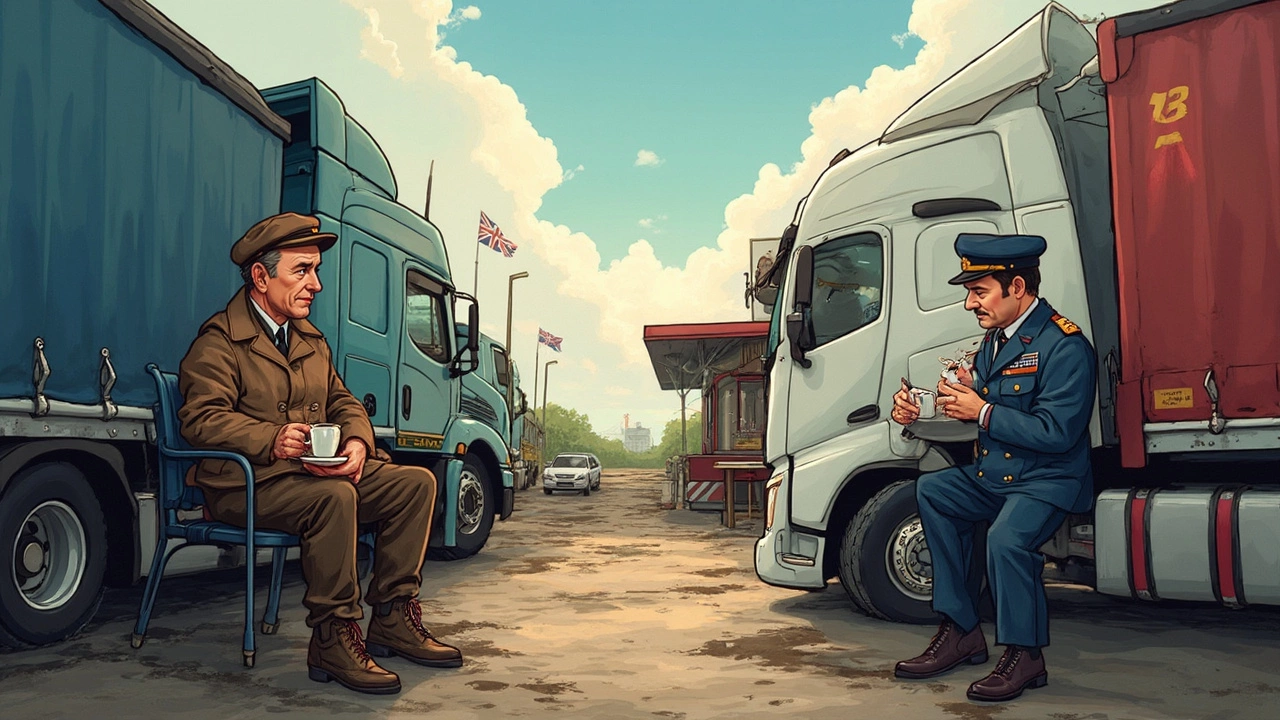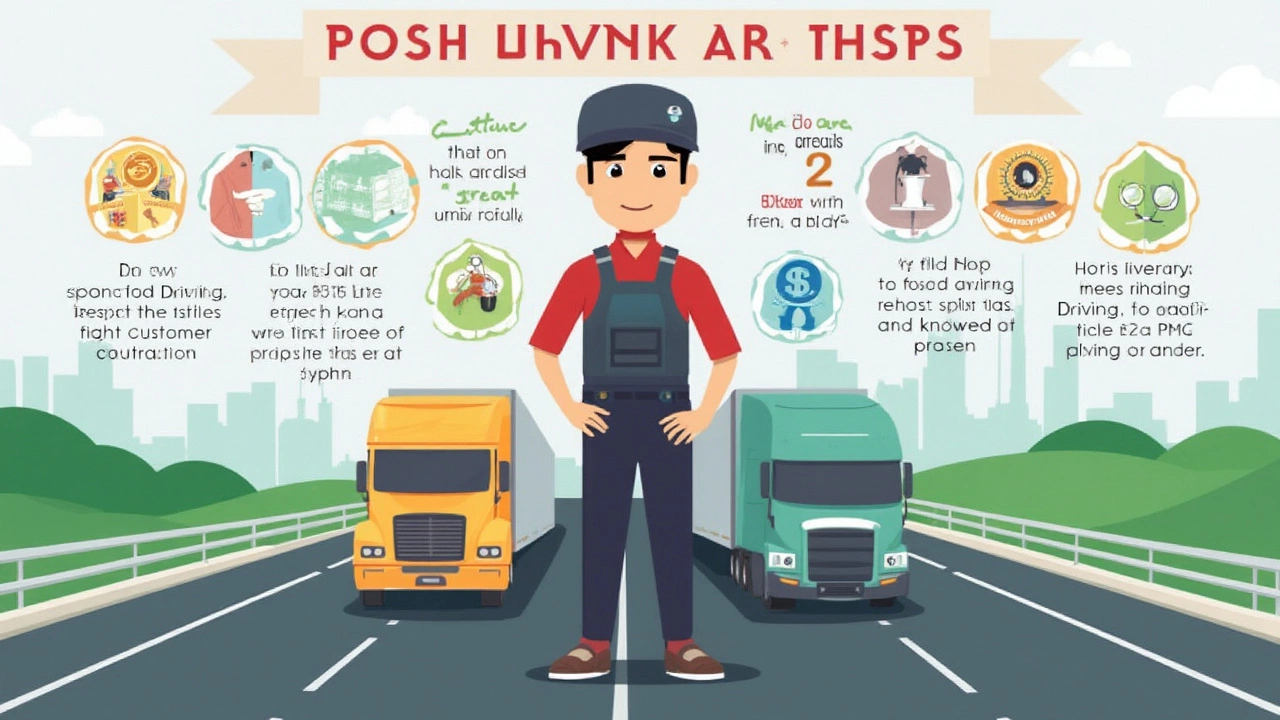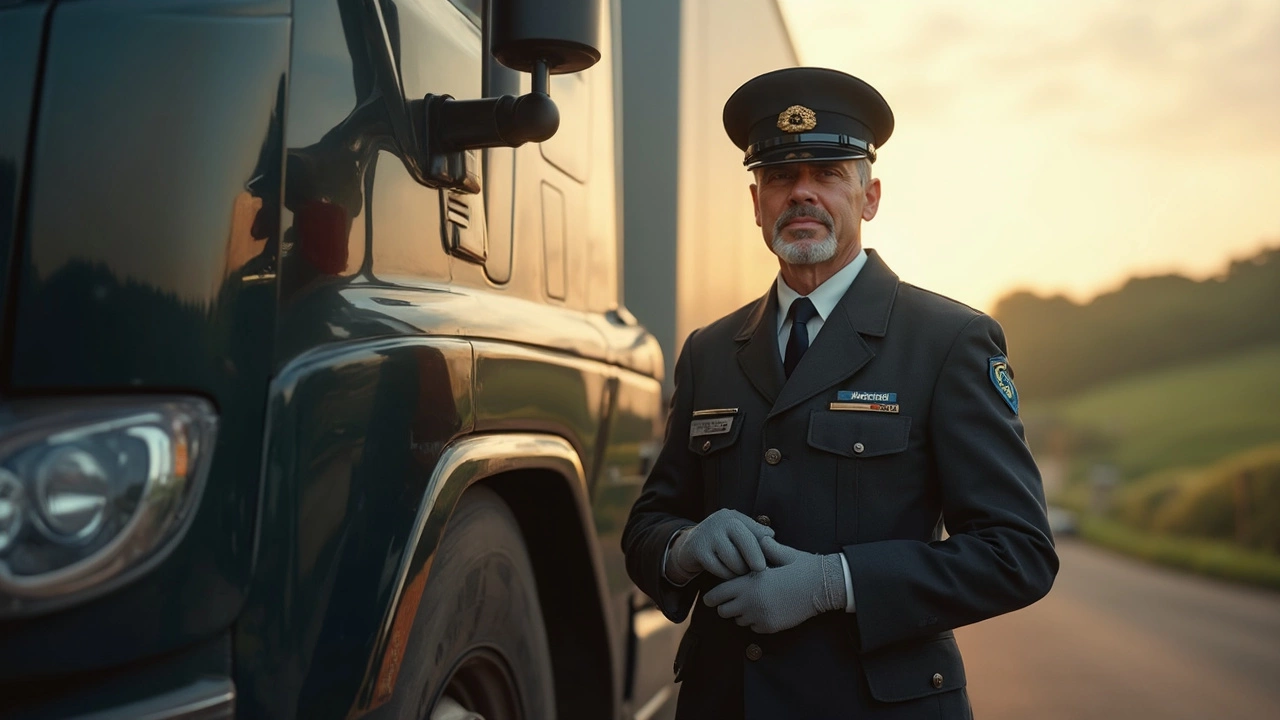People throw around 'posh driver' in the HGV world more than you’d think. Usually, it means someone who drives the fancier trucks, maybe has all the branded gear, and always has a spotless lorry. It's not an official certificate or job—it's more of a tongue-in-cheek label, but it sticks. Someone might give you that title if you’re seen hauling for high-end clients, driving new Volvos with leather seats, or sipping from a reusable coffee mug instead of a battered thermos at a truck stop.
The label isn’t just about looks, though. In HGV circles, a 'posh driver' often gets connected with extra training, top driving manners, and knowing the ropes with customer service. Sometimes there’s a bit of jealousy or ribbing behind the name, but there’s real respect too. Want to be called 'posh' in this game? It starts with doing things a notch above what’s expected.
- What Does 'Posh Driver' Mean?
- Where Did the Term Come From?
- Posh Drivers vs. Regular Drivers: The Stereotypes
- How to Become a Stand-Out (aka 'Posh') HGV Driver
- Why Image Matters in HGV Driving
What Does 'Posh Driver' Mean?
If you spend time around lorry drivers, you'll hear the phrase 'posh driver' tossed about, but what does it actually mean? In the HGV world, this isn’t an official job or a formal title. It’s more of a nickname that hints at a driver who’s got a reputation for going a bit above the basics.
Someone might get called a 'posh driver' if they drive the shiny new trucks, like those top-end Volvos or Mercedes, with leather seats and tech features most drivers just admire from a distance. You’ll spot them—even their boots are clean and their uniforms are fresh. They're proud of keeping their rig spotless, inside and out. That focus on details can win them plenty of respect (and a bit of banter) from other drivers.
The 'posh' in this sense also means the driver takes pride in things like customer service, paperwork, and punctuality. They don’t bluff their way through seeing clients; they’re polite, quick with a cheeky smile, and they know the value of a handshake. A 2022 survey by the Road Haulage Association found that companies are more likely to give their newest, most valuable trucks to drivers with not just a clean licence but who project a professional image, too.
"A 'posh driver' isn’t just about what you drive—it’s about how you drive, how you talk to customers, and how you look after your kit. Companies notice that," says Kevin Brown, veteran HGV trainer at Truck Skills UK.
The posh driver tag is also used for those who've got extra qualifications—ADR for hazardous goods, hiab or moffett tickets, or advanced defensive driving courses. It's not about showing off; it's about being trusted to take the best work, handle trickier jobs, and bring in steady repeat business for a company.
At the end of the day, being a 'posh driver' in HGV isn’t about snobbery. It’s about setting a high bar, looking after yourself and your gear, and making the bosses think, “that’s the driver I trust for my top clients.”
Where Did the Term Come From?
The word “posh” has been around forever in British slang, often meaning something fancy, upper-class, or polished. But toss it into truck driver circles, and it gets a new twist. In the HGV world, the term kicked off as a bit of banter, mostly in the ’80s and ’90s, between drivers working for top-name firms and those handling general haulage. The drivers with the shiny new rigs, pressed uniforms, and steady long-distance contracts got tagged as "posh drivers." It wasn’t always a compliment back then—sometimes it came with a wink or a roll of the eyes.
This label grew legs as more companies started pushing for a cleaner, more professional image. Think about it: companies like Eddie Stobart or DHL made their drivers stand out, not just with the lorries but with driver appearance and attitude. Suddenly, being a so-called "posh driver" started meaning you had higher expectations on you and probably earned a bit more, too.
Even now, with the rise of social media, you’ll see #PoshDriver pop up on trucking Instagram accounts—usually showing off a meticulously clean cab, a fancy uniform, or the latest tech in the cab. It’s funny how the joke has turned into a point of pride for some. In short, the tag came from years of ribbing between different types of truckers, but today, in the HGV training space, it’s often used to talk about someone smashing the standards and setting the bar on professionalism.

Posh Drivers vs. Regular Drivers: The Stereotypes
Let’s get real: in the HGV world, there’s a clear image of what counts as a "posh driver" versus someone more down-to-earth. This isn’t about being richer or fancier at home—it comes down to style, attitude, and sometimes, the type of lorry you drive.
If you ask around truck stops, you’ll hear that posh drivers tend to roll in with late-model trucks—think new DAF, Scania, or Mercedes cabs loaded with tech and leather interiors. Regular drivers might have older lorries that get the job done, but don’t turn heads. You’ll spot the difference by how well their truck is kept, too. Posh drivers treat theirs like a mobile living room; everything is spotless, and even the kettle matches the curtains. Regular drivers might have a bit more clutter—a spare pair of socks on the dash, dog hair from their mate (my Rufus sheds everywhere), or takeaway wrappers on the passenger seat.
- Posh driver: Drives for big companies, often with strict uniform codes and delivery slots. They usually deliver high-value goods, fragile electronics, or luxury food. Some even go international with European routes.
- Regular driver: Might be on the tipper, skip, or tanker runs, sometimes for smaller hauliers, sometimes self-employed. These jobs can mean getting muddy or dealing with tough conditions, like farms or building sites.
And here’s the stereotype kicker: posh drivers rarely get their hands dirty. You’ll hear jokes about how they’ll use gloves to check the oil or call the depot if there’s even a splash of mud on the tyres. Regular drivers? They’re usually seen as more practical—jumping out to fix a taillight, chatting with loaders, or hauling tarps without a fuss.
Looks aren’t the only thing that separates them. There’s a difference in pay and perks. Drivers doing high-end, scheduled jobs tend to make more, since the firms expect top standards and give proper breaks. Check out this quick table for a rough idea (based on industry figures from 2024):
| Type | Average Yearly Pay (£) | Typical Perks |
|---|---|---|
| Posh Driver | 38,000 | Latest cabs, uniforms, set routes, better rest stops |
| Regular Driver | 32,000 | Flexible jobs, more independence, varied work |
Remember, these are broad strokes—there are plenty of exceptions. Still, the "posh driver" reputation does affect how drivers get treated by companies and even by other drivers. Some say posh drivers have it easier. Others reckon regular drivers keep the wheels of the country turning, no matter how muddy it gets.
How to Become a Stand-Out (aka 'Posh') HGV Driver
If you want to be known as a stand-out or even a 'posh driver' in the HGV world, you’ll have to take things up a gear. This isn’t about putting on airs—it's about raising your standards and showing you care about your work and your rig. Here’s what actually gets noticed on the road and in the industry.
- Top-Notch Vehicle Care: A true 'posh' driver keeps their lorry clean, well-serviced, and in tip-top shape inside and out. It’s not just for looks—companies track vehicle conditions and drivers who keep things tidy tend to get better routes.
- Level Up Your Training: Go beyond the basics. Advanced driving courses (like ADR for hazardous goods or CPC extras) don’t just look good—they open better job doors. About 38% of UK hauliers say extra licenses lead to better pay or promotions.
- Professional Kit: Uniforms matter more than you think. Top drivers invest in durable, branded high-vis jackets, good boots, and sometimes those little extras like a digital logbook or hands-free tech.
- Excel at Customer Service: The best drivers don’t just drop and go. They know how to talk to warehouse staff, sign off deliveries properly, and leave a good impression. Companies will remember you if customers mention your name in feedback calls.
- Build a Good Reputation: Word travels fast at truck stops and in company break rooms. Get known for being reliable, safe, and on time. Agencies and employers love giving the best runs to drivers with a solid rep.
Want to see how the top drivers compare? Here’s a quick look:
| Driver Type | Extra Certifications | Average Vehicle Age | Average Salary (UK, 2024) |
|---|---|---|---|
| 'Posh' HGV Driver | Yes (C+E, ADR, CPC extras) | 2-4 years | £42,000 |
| Standard HGV Driver | C+E or basic CPC | 5-8 years | £37,000 |
Think about networking too. Drivers who know their stuff and keep things slick sometimes end up as trainers or managers—or just bag the best gigs. Putting in that bit of extra effort can really pay off, both in respect and in your paycheck.

Why Image Matters in HGV Driving
In HGV driving, image is more than just trying to look smart on the job. People notice how you keep your truck, how you handle yourself at delivery sites, and how you interact with clients. Companies are way more likely to give repeat work to drivers who represent them well. Some big clients won’t even let drivers unload if they show up in dirty high-vis or scruffy boots. A survey from the Road Haulage Association showed that professional appearance is the third most important quality, right behind timekeeping and safe driving.
On the road, other drivers and even the police seem to treat a well-presented lorry with more respect. The same goes for truck stops—walk in looking like you care, and you won’t get written off as an amateur. It’s not about spending loads on gear, either. It comes down to tidiness, wearing branded kit when you’re given it, and making sure your cab isn’t a health hazard. Most companies now include an image section in their driver handbook, and some even spot-check cabs for cleanliness and PPE.
Don’t forget the social side. Word gets around in this industry. If you’re the driver who keeps their vehicle gleaming and acts calmly with customers, you get recommended for better jobs. The 'posh driver' vibe is basically shorthand for being reliable, presentable, and easy to work with. If you’re aiming for contracts with corporate clients or luxury brands, looking and acting the part is a must.
- Keep a change of clean workwear in your cab—accidents happen, and spares save the day.
- Wipe down your dashboard and mirrors weekly; grime builds up quickly out on the road.
- Always have branded paperwork ready and present yourself with a quick intro at delivery sites.
- Stick to the posh driver standard: show respect for the vehicle and the client every single time.
In short, your image isn’t about showing off, it’s about building trust and grabbing the best gigs out there. Simple steps boost your chance at more work and respect—no designer shoes needed.

